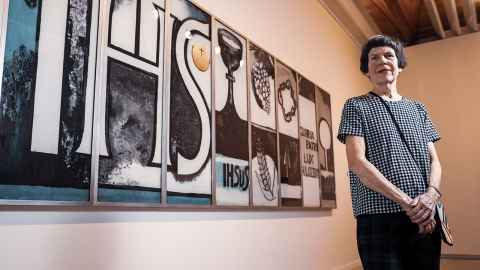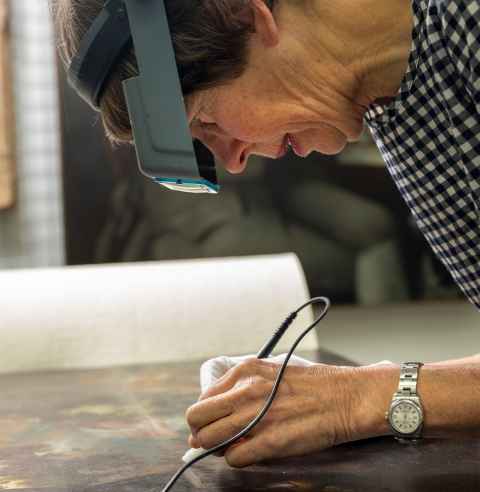Sarah Hillary: saving art
25 November 2019
It has taken years of training for Auckland Art Gallery’s Principal Conservator Sarah Hillary to become a leading light in painting conservation and restoration.

Auckland Art Gallery’s Principal Conservator Sarah Hillary is a heroine of art.
She’s been hard at work in the conservation laboratory at the Gallery, saving neglected works of art for 36 years. Some of her high-profile rescues include repairing canvases damaged during thefts – works by James Tissot and Colin McCahon – while her research into painting techniques has identified several fakes, some in public collections.
International journals have featured her indepth research in technical art history, which involves the scientific analysis of artworks to establish how and when they were made. Her meticulous work contributed to a re-evaluation of the painting of Saint Sebastian by Italian 17th-century master Guido Reni that’s held in the Auckland Art Gallery. That painting is now considered to be the original work while others that exist in galleries around the world are copies.
As well as being an exhibiting artist at the Anna Miles Gallery in Auckland, Sarah regularly contributes to the exhibition programme at the Auckland Art Gallery. Her displays provide insights into how paintings are made, showing how microscopic analysis of minute cross-sections can reveal the number of layers of paint on the surface of a painting.
“I showed visitors to the Frances Hodgkins exhibition how techniques of analysis revealed a figure painting beneath a still life, and how the artist built up her surfaces with up to 40 layers of oil paint,” says Sarah.
“Similar techniques also revealed the use of photography to produce Gottfried Lindauer’s startlingly accurate portraits … we examined them under infrared light.”
Sarah’s collaborations with researchers at the Tate Gallery in London and the Getty Conservation Institute in Los Angeles have contributed significantly to the understanding of how artists based in Aotearoa used modern materials to produce their work.

All this has taken years of training. Excelling academically at high school, Sarah enrolled at university directly from sixth form. She began her medical intermediate year at Otago in 1974, but her study was interrupted by the death of her mother, Louise, and sister Belinda in a plane crash in Nepal in 1975. They’d been on the way to meet up with Sarah’s father, Sir Edmund Hillary.
Later, Sarah studied psychology and chemistry for an undergraduate degree, but switched to the University of Auckland to get married and be closer to family. It was there she graduated in art history. Volunteering at the Auckland Art Gallery, she applied for the Conservation of Cultural Materials course at the Canberra College of Advanced Education where she completed a Masters of Applied Science.
“That gave me a grounding in the three areas of object, paper and painting conservation, which was vital before I could do what I do.”
She then specialised in painting conservation.
“I decided to return to New Zealand in 1983 to take up an internship, working with the incumbent conservator at the Auckland Art Gallery, and was later given a permanent role.”
After working on numerous paintings from provincial and regional galleries as part of the gallery’s Northern Regional Conservation service, Sarah won a Getty Advanced Internship at the Williamstown Regional Art Conservation Laboratory in Massachusetts in 1986.
Returning to work at the Auckland Art Gallery, she now manages a staff of six and knowledge of her skills has spread through the conservation service the gallery provides for artworks owned by other institutions, corporations and members of the public.
“It’s important to keep learning,” she says. “I update my knowledge by going to conferences and scientific meetings. There are always new techniques or improvements.”
Her working methods must also adhere to international standards: each examination of a painting’s surface under raking light reveals every scrape and accretion recorded in a condition report.
“It’s also really important to give careful consideration to the treatment approach ... to bear in mind the intentions of the artist and the originality of the artwork.”
Reversibility is also important.
“In the future, our understanding of an artwork might surpass current knowledge,” she says. “We need to make sure the treatments we use today don’t hinder the work of conservators in the future.”
By Linda Tyler
This article first appeared in the Spring 2019 issue of Ingenio.
Contact Ingenio.